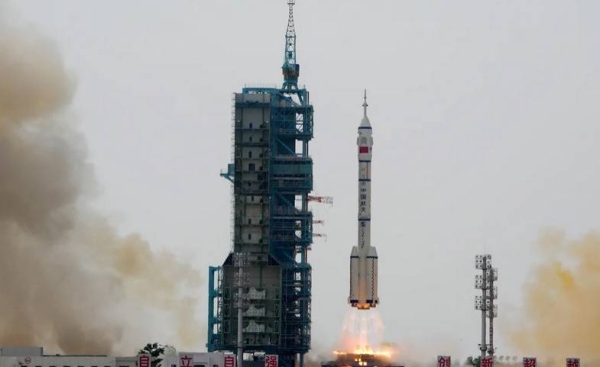
China sent its first civilian astronaut into orbit on Tuesday, as it launched the Shenzhou-16 mission to its space station for its second in-orbit crew rotation, marking another step forward for the country’s ambitious space program.
The three Shenzhou-16 astronauts blasted off from the Jiuquan Satellite Launch Center in the desert of China’s Gansu province at 9:31 a.m. on Tuesday morning, headed for the Tiangong space station orbiting earth.
The crew – Jing Haipeng, Zhu Yangzhu, and Gui Haichao – will take over from the Shenzhou-15 astronauts, who have been abroad China’s newly completed Tiangong space station since November, to start their own five-month stint aboard the station.
It is China’s fifth manned mission to the space station since 2021.
The Shenzhou-15 crew aboard the station were pictured watching the launch of their replacement crew via live stream. The two crews were expected to meet on the station around 6.5 hours time after the launch, state media said.
Among the Shenzhou-16 crew, Gui, a professor at China’s prestigious aeronautics institution Beihang University who pursued his postdoctoral studies in Canada, is the first Chinese civilian to be on a spaceflight. All other astronauts have been members of China’s People’s Liberation Army.
Gui will operate payloads for space experiments, while Jing and Zhu will operate and manage the spacecraft, in addition to carrying out technical tests, the China Manned Space Agency (CMSA) said in a press conference on Monday introducing the crew.
Jing, the mission commander, is a space veteran who was among China’s first team of astronauts in 1998 and has already completed three manned flight missions. The mission marks the first space flights for Zhu and Gui, both born in 1986.
Gui’s selection for the crew generated keen interest in Chinese online media, not only for his position as the first civilian astronaut, but because an accessory he was wearing in official photos that’s not typically seen on those headed to space – eyeglasses.
Several media outlets on Monday responded to the online discussion over how a person without perfect vision could be physically cleared for a space mission.
State-run China Daily cited former astronaut Yang Liwei, now a top official in China’s manned space program, explaining that as division of labor on missions became more specialized, there were different criteria for different crew members.
Several articles also detailed the rigorous training Gui underwent in advance of the mission, including desert field survival, sleep deprivation tests, centerfuge training and underwater drills for operational skills.
NASA’s rules for its astronauts states that “distant and near visual acuity must be correctable to 20/20 in each eye”. But it adds: “The use of glasses is acceptable.”
The Shenzhou-16 launch comes as China has rapidly been advancing its capabilities in space – including through the establishment of its Tiangong space station, which completed its basic construction last year and is expected to operate and host astronauts for at least a decade.
This could make it the sole in-orbit outpost for scientific research after the expected end of operations for the International Space Station in 2030.
China has sought to open up its station to collaboration with international partners, including by hosting experiments from other countries.
Beijing for years has been leveraging of its rising prowess as a global space power to offer partnerships and development opportunities to other countries its as part of its diplomacy.
While in-orbit construction of the space station’s T-shaped, three-module structure was completed last year, there are plans to expand of the structure and extend its research capabilities in the coming years, according to state media.
Tiangong’s core module first entered orbit in 2021, marking the first major step in a space station dream envisioned by the government since 1992.
The moment was hailed by official media at the time as “formally embarking on the buildup of one of the humanity’s largest and most sophisticated space-based facilities.”
China will have three space missions for its space station application and development in 2023, the CMSA said earlier this year.
In addition to Tuesday’s launch, those include the cargo craft Tianzhou-6, which was launched earlier this month, and the second crewed spaceship Shenzhou-17 later this year.
In its press conference Monday, the CMSA also reiterated China’s plan for a manned lunar landing by 2030. — CNNa








